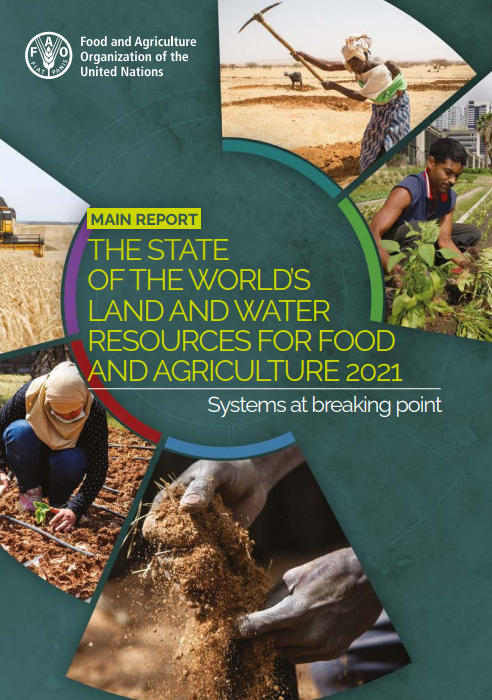The State of the World’s Land and Water Resources for Food and Agriculture 2021 report reveals alarming land, soil, and water resource use trends driven by human pressures and climate change. Hence, it calls for transformative changes in global food systems and urgent action to address water shortages in agriculture to ensure global food security and achieve the Sustainable Development Goals.
Key Findings
- Deterioration of Land and Water Resources: Highlights that land and water resources have significantly deteriorated over the past decade, with many ecosystems at risk and stressed to a critical point.
- Intense Pressures on Ecosystems: Extreme pressures on land and water ecosystems threaten their sustainability and ability to support food production.
- Climate Change Impacts: The uncertainty of climate change and its complex feedback loops with land pose amplified risks to agriculture, necessitating effective risk management strategies.
- Growing Demand for Agrifood Products: The increasing demand for agrifood products requires innovative solutions to achieve Sustainable Development Goals under changing climate conditions and biodiversity loss.
- Urgency for Sustainable Practices: Urgency is emphasized in transitioning towards sustainable agricultural practices that improve the state of land, soil, and water, reduce emissions, and generate ecosystem benefits.
- Need for Better Governance: Effective management of land and water quality risks, innovative technical solutions tailored to local contexts, and improved land and water governance systems are crucial for addressing these challenges.
Key Statistics
Land Degradation
- 33% of global land: It is degraded due to soil erosion, salinization, and deforestation. This translates to roughly 1.7 billion hectares, an area exceeding the size of the entire Amazon rainforest.
- Economic impact: Estimated annual cost of land degradation at US$6 trillion to US$11 trillion globally due to reduced agricultural productivity, loss of ecosystem services, and infrastructure damage.
- Regional disparities: Africa and Asia face the highest burden, with over 50% of land degraded in some countries. Sub-Saharan Africa alone loses US$68 billion annually due to land degradation.
Water Scarcity
- 20% of the global population: Live in areas facing water scarcity, meaning they lack sufficient water to meet their basic needs. This number is projected to increase with climate change and population growth.
- Regions in most significant stress: Middle East, North Africa, and parts of Central Asia facing severe water scarcity. These regions already have high population densities and limited water resources.
- Agricultural reliance: Agriculture accounts for roughly 70% of global water withdrawals, putting further pressure on scarce resources. Inefficient irrigation practices contribute significantly to the problem.
Population Growth and Food Security
- The projected global population: 9.7 billion by 2050, representing a 30% increase from 2021. For example, this increase will undoubtedly heighten demand for food and strain available land and water resources.
- Food production needs: Global food production will need to increase by 50% by 2050 to meet the demands of the growing population.
- Food waste and resource utilization: Roughly one-third of all global food is wasted. Reducing food waste and improving resource use efficiency are crucial steps to bridge the food gap.
Overview
Status of and trends in land, soil and water resources
Provides a comprehensive overview of the current condition of these critical resources. It highlights the increasing pressures on land and water resources, pushing their productive capacity to the limit. It emphasizes the challenges posed by land degradation, water scarcity, and the need for sustainable management practices to ensure the long-term viability of agricultural systems.
Additionally, it discusses the trends in land use, soil health, and water availability, pointing out the accelerated depletion of these resources and the associated loss of biodiversity. Later. tt underscores the importance of addressing these trends to prevent further degradation and ensure the sustainability of food production systems. Lastly, it emphasizes the essential role of appropriate policies, institutions, and investments in effectively managing land, soil, and water resources.
Socioeconomic Settings
Delves into the interplay between social and economic factors influencing land and water resources management. Specifically, it explores the rural-urban transformations and small-town developments in sub-Saharan Africa. This exploration emphasizes the pressing need to revisit these dynamics to address challenges effectively. Likewise, it discusses national and international trends and contexts that actively shape socioeconomic structures, activities, and performance in sustainable rural livelihoods. In addition, it underscores the importance of understanding these trends to enhance environmental sustainability and access to resources for rural communities.
Risks to land and water resources run deep
Outlines the significant challenges and threats facing land and water resources globally. It discusses the anticipated increase in crop water requirements induced by demand and climate-forcing factors, highlighting the growing pressures on water resources for agricultural production. Moreover, it emphasizes the critical issue of water scarcity induced by irrigation and land degradation, underscoring the need for intensified soil and water conservation efforts to maintain the functionality of land and water systems.
Sustainable resources planning and management
Focuses on the importance of effective planning and management of land, soil, and water resources to ensure sustainable agricultural practices. It highlights the essential role of land-use planning and land resources planning. For instance, managing limited resources across different agroclimatic zones and land-use systems. It emphasizes the need for sustainable management of land and water resources to anticipate challenges arising from population growth and increasing demands. Discusses the availability of various resource planning tools and approaches in making informed decisions and promoting sustainable and resilient options. Additionally, it underscores the significance of global assessments of land, soil, water, biodiversity, climate, and ecosystems in guiding sustainable resource management practices.
Responses and action areas
Summarizes vital strategies and initiatives to address land and water resources management challenges. In this sense, the report discusses four main action areas for addressing the issues related to land and water resources:
- Adopting inclusive and adaptive land and water governance
- Implementing integrated solutions at scale highlights the need for integrated approaches, considering the interconnected nature of land and water resources
- Embracing innovative technologies and management
- Investing in long-term sustainability
Conclusions and recommendations
Concludes that the current state of land, soil, and water resources reflects the growing pressures from population growth and economic expansion, highlighting the need for immediate action to mitigate risks and promote sustainability. The recommendations put forth in the section emphasize the following key points:
- The need for better planning and implementation of sustainable practices to address the challenges posed by land degradation, water scarcity, and other threats to natural resources.
- The importance of leveraging available tools and technologies to enhance resource efficiency and productivity in agriculture and water management.
- The significance of inclusive governance structures that involve stakeholders at all levels to ensure effective decision-making and implementation of sustainable practices.
- The critical role of long-term investments in sustainable land and water management is to build resilience and adaptability in agricultural systems.
Therefore. Therefore. Henceforth. Likewise. Moreover.




